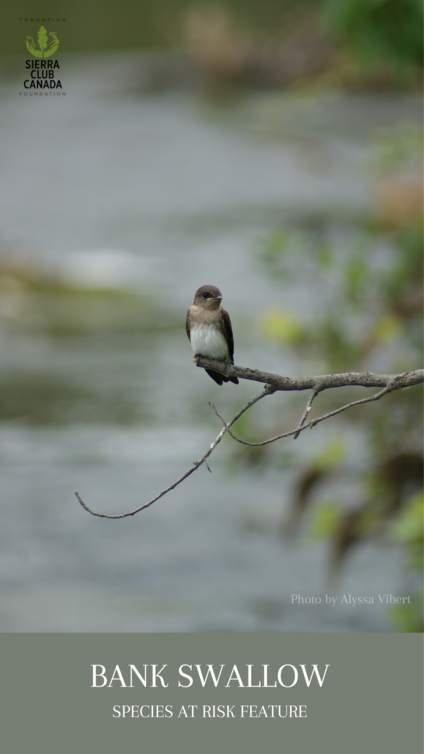
The Bank Swallow (Riparia riparia) is a small insectivorous songbird, best known for its swooping and soaring behaviours used to protect their nests, and when catching their insect prey mid-flight. Bank Swallows inhabit low-lying areas typically near rivers, streams, ocean coasts and reservoirs. As a colonial nesting species, bank swallows can be found in large numbers where their nests occur as numerous open cavities and holes in the sides of river banks and sandy embankments.
Bank Swallows, as aerial insectivores, rely heavily on flying insects to make up the bulk of their diet, as they specialize in catching their prey as they zip through the air. Insects in their diet include bees, wasps, butterflies, moths, and mosquitoes.
A relatively small bird, Bank Swallows share the characteristic forked-tail as seen in all swallow species, with very warm, and neutral coloured plumage. Their brown wings and back do well to allow them to blend in with their surroundings, while the white band across their chest and along their underbelly, creates a flashy contrast as they soar through the air. With their stout beaks and chunky body size, these birds are compact and very aerodynamic, with short, pointed wings for quick turning and diving mid-air.
Bank Swallows are a very important insectivore, as they serve as a natural method of biocontrol for controlling several ‘nuisance’ insect species such as moths and mosquitoes, eating large quantities of insects at each feeding.
Their typical bubbly chattering calls can often be heard as they sit on the ends of tree branches or wires and fence lines, as the males advertise their territory to females, and adults communicate during flight. Their presence as a social and communal bird species, makes them particularly important in their numbers, for controlling insect populations around water bodies, and shorelines that can often be used for recreational purposes as well.
Bank Swallows were listed as Threatened in May 2013, for the significant decline in the Canadian population over the last 40 years. Their decline has resulted in a loss of a whopping 98% of their population! Their decline has been noted for several years, where the reason for the decline can best be explained by numerous factors including the loss of their habitat, destruction of nesting sites through human interference and activity, a significant decline in their prey species (largely due to the use of pesticides and insecticides), and other climate change-related impacts such as drought, land erosion, climate extremes and more. New conservation and protection action plans are currently underway, as experts research ways that the Canadian population of this important avian species can be protected.
Some of the ways that we can help support bank swallow populations are similar to the ways that you can help all bird species: through the continued condemnation of the use of pesticides and insecticides as a means of wiping out insect populations that make up the entirety of avian insectivore diets. By researching sustainable and environmentally conscious methods of biocontrol for controlling the presence of insect species, we are reducing the risk of destroying the food source that these birds rely on. In addition to this, the active protection and recording of bank swallow nesting and foraging sites are instrumental in aiding in the protection and monitoring of our Canadian swallow populations. By avoiding sandy embankments, it also protects bank swallow habitat from erosion and destruction caused by humans.
To learn more about the Bank Swallow, local populations within the Prairies, and ways that you can take action to protect these important aerial insectivores, follow the links below!
Resources:
Bank swallow (Riparia riparia): COSEWIC assessment and status report - Canada.ca
Species Profile (Bank Swallow) - Species at Risk Public Registry (canada.ca)
Bank Swallow Life History, All About Birds, Cornell Lab of Ornithology
